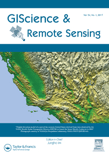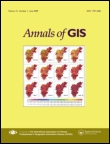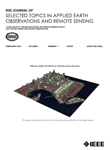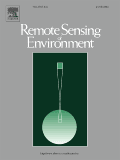
Remote Sensing Letters
metrics 2024
Bridging Disciplines with Cutting-edge Remote Sensing Research
Introduction
Remote Sensing Letters, published by Taylor & Francis Ltd, is a distinguished journal that serves a vital role in the fields of Earth and Planetary Sciences as well as Electrical and Electronic Engineering. With an ISSN of 2150-704X and an E-ISSN of 2150-7058, this journal has been disseminating cutting-edge research since its inception in 2010, converging toward a future of innovation and technological advancement scheduled through 2024. The journal is recognized for its impactful scholarship, achieving a Q2 quartile ranking in both its categories as of 2023, highlighting its significance in enhancing academic discourse and applications in remote sensing methodologies. Although it does not operate under an open-access model, it provides access to essential findings that address contemporary challenges in the remote sensing domain. Located in the United Kingdom at 2-4 Park Square, Milton Park, Abingdon, OX14 4RN, Remote Sensing Letters is a crucial resource for researchers, professionals, and students committed to advancing their understanding and application of remote sensing technologies.
Metrics 2024
 0.46
0.46 1.40
1.40 1.90
1.90 56
56Metrics History
Rank 2024
IF (Web Of Science)
JCI (Web Of Science)
Quartile History
Similar Journals

CANADIAN JOURNAL OF REMOTE SENSING
Exploring the Frontiers of Remote Sensing ResearchCanadian Journal of Remote Sensing is a prestigious, peer-reviewed journal published by Taylor & Francis Inc., based in the United Kingdom. With an impressive impact factor and a Scopus ranking placing it in the 76th percentile among general Earth and Planetary Sciences, this journal is integral for researchers and professionals exploring the dynamic field of remote sensing. Since its inception in 1975 and now continuing through to 2024, it has been a platform for disseminating cutting-edge research and advancements in both methodologies and applications across diverse environments. As of 2023, it has transitioned to Open Access, ensuring wider access to its scholarly articles, which cover a broad spectrum of topics including satellite imagery, data interpretation, and environmental monitoring. This journal is not only crucial for fostering innovation and collaboration within Earth sciences but also serves as a critical resource for students and academics alike, eager to stay abreast of the latest developments in remote sensing technology and methodology.

GIScience & Remote Sensing
Unlocking the Future of Geographic KnowledgeGIScience & Remote Sensing, published by Taylor & Francis Ltd, stands as a leading journal in the realm of Earth and Planetary Sciences, holding a prestigious Q1 ranking. Since its transition to Open Access in 2022, the journal has significantly broadened its reach, enabling researchers, professionals, and students across the globe to disseminate and access cutting-edge research related to geographic information science and remote sensing technologies. With a focus on publishing high-quality, peer-reviewed articles that contribute to the understanding of the Earth’s processes, environments, and interactions, this journal not only supports advancements in scientific knowledge but also fosters interdisciplinary collaboration. Based in the United Kingdom, GIScience & Remote Sensing continues to pave the way for innovative methodologies and applications, solidifying its vital role within the scientific community.

Remote Sensing
Connecting Global Researchers for a Deeper Understanding of EarthRemote Sensing is a highly esteemed journal published by MDPI, dedicated to the domain of Earth and Planetary Sciences. With an impressive impact factor reflected in its rank of #16 out of 195 in the general Earth and Planetary Sciences category, this journal achieves a commendable 92nd percentile among its peers, indicating its significant contribution to the field. Since its inception in 2009 as an Open Access journal, it has enabled researchers, professionals, and students from around the globe to access high-quality, peer-reviewed articles that delve into the latest advancements in remote sensing technologies, methodologies, and applications. Based in Switzerland, Remote Sensing serves as a vital platform for disseminating innovative research that supports and enhances our understanding of Earth's processes and environments, ensuring scientific knowledge remains freely accessible and impactful.

ISPRS International Journal of Geo-Information
Advancing geospatial understanding for a better tomorrow.ISPRS International Journal of Geo-Information, published by MDPI, stands at the forefront of the field of geospatial sciences, contributing valuable knowledge and research insights since its inception in 2012. This open access journal, which boasts an impressive collection of articles that emphasize the integration of geographic information systems (GIS) in Earth and planetary sciences, currently achieves a remarkable standing, with a 2023 impact factor ranking in the Q1 category for both Earth and Planetary Sciences and Geography, Planning and Development. Researchers and professionals engaged in the study of spatial data, remote sensing, and innovative geoinformation technologies will find the journal an essential resource, offering diverse perspectives and methodologies. With its open access model, the journal aims to promote the dissemination of knowledge globally, fostering collaboration among scholars while pushing the boundaries of research in geoinformation disciplines. The journal is based in Switzerland and is well-positioned to contribute significantly to the understanding and application of geospatial data for societal advancements.

European Journal of Remote Sensing
Advancing the Frontiers of Remote Sensing KnowledgeThe European Journal of Remote Sensing, published by Taylor & Francis Ltd, stands as a pivotal resource in the domains of applied mathematics, atmospheric science, and earth sciences. Since its transition to Open Access in 2012, the journal has facilitated unrestricted knowledge dissemination, fostering collaboration and innovation among researchers. With a notable impact factor reflected in its quartile rankings—achieving Q2 in applied mathematics and atmospheric science, and Q1 in miscellaneous environmental science—the journal is a respected platform for high-quality research. Based in the United Kingdom, it encompasses a wide range of topics related to remote sensing technologies and their application in environmental monitoring. Researchers and professionals in these fields will find the journal indispensable for its commitment to advancing scientific understanding and promoting the use of remote sensing methodologies in tackling contemporary environmental challenges.

South African Journal of Geomatics
Pioneering Insights at the Intersection of Geography and TechnologySouth African Journal of Geomatics is a pivotal platform dedicated to the advancement of geomatics, focusing on the dynamic intersection of geographic information science, surveying, and mapping technologies. Published by CONSAS CONFERENCE, the journal serves as a crucial resource for researchers, professionals, and students in the geomatics field, providing insightful, peer-reviewed articles that explore contemporary challenges and innovations. Operating under an open-access model, the journal ensures the wide dissemination of knowledge, promoting collaboration and scholarly exchange among the global geomatics community. With a commitment to enhancing the visibility of significant research and fostering academic discourse, the South African Journal of Geomatics plays a vital role in contributing to the development of this essential discipline in South Africa and beyond.

Annals of GIS
Shaping the Landscape of Geoinformatics ResearchWelcome to the Annals of GIS, a leading academic journal published by Taylor & Francis Ltd, dedicated to advancing the field of Geographic Information Science and its applications. With an ISSN of 1947-5683 and an E-ISSN of 1947-5691, this Open Access journal has been ensuring wide accessibility since 2019, thereby bolstering the dissemination of knowledge in areas such as remote sensing, spatial analysis, and geoinformatics. Hailing from the United Kingdom, the journal ranks impressively within its categories, achieving a Q2 status in Computer Science Applications and a prestigious Q1 ranking in Earth and Planetary Sciences for 2023, placing it in the top 10% among its peers. With a focus on innovative research spanning from 2009 to 2024, the Annals of GIS serves as a vital platform for researchers, professionals, and students alike, providing insights and fostering discussions that push the boundaries of geographic technologies and their real-world applications.

IEEE Journal of Selected Topics in Applied Earth Observations and Remote Sensing
Empowering Scholars with Cutting-edge Earth Observation Research.IEEE Journal of Selected Topics in Applied Earth Observations and Remote Sensing is a premier peer-reviewed journal published by the IEEE-INST ELECTRICAL ELECTRONICS ENGINEERS INC, focused on advancing the field of Earth observation and remote sensing technologies. With an impressive impact factor, this journal ranks in the top quartile (Q1) for both Atmospheric Science and Computers in Earth Sciences, underscoring its significance and influence in the academic community. Open access since 2020, it facilitates broader dissemination of research findings to enhance global visibility and accessibility for researchers, professionals, and students alike. Spanning the years from 2008 to 2024, the journal covers a myriad of topics that highlight innovative applications of remote sensing data and technologies in addressing environmental challenges. With a Scopus ranking placing it in the 91st and 89th percentiles, respectively, in its categories, the journal serves as a vital resource for advancing scholarly discourse and collaboration in Earth sciences.

REMOTE SENSING OF ENVIRONMENT
Innovative Imaging for a Changing Planet.REMOTE SENSING OF ENVIRONMENT, published by Elsevier Science Inc, is a premier academic journal specializing in the interdisciplinary field of earth observation and remote sensing technologies. With an impressive impact factor and classified in the Q1 category for Computer Science in Earth Sciences, Geology, and Soil Science as of 2023, this journal serves as a vital resource for researchers, professionals, and students alike. The journal, which has been disseminating high-quality research since its inception in 1969, provides a platform for the exploration of innovative methodologies and applications in the assessment of environmental changes and resource management through advanced imaging techniques. While not an open-access journal, REMOTE SENSING OF ENVIRONMENT offers access options that make cutting-edge research accessible to its audience. Its strategic focus on critical issues pertaining to environmental monitoring and sustainable practices underscores its role in enhancing our understanding of the planet’s dynamics.

Geo-Spatial Information Science
Pioneering Research at the Crossroads of Geography and ComputingGeo-Spatial Information Science, published by TAYLOR & FRANCIS LTD, is a premier open-access journal that has been at the forefront of disseminating cutting-edge research since its inception in 1998. With an ISSN of 1009-5020 and an E-ISSN of 1993-5153, this journal plays a pivotal role in the fields of Computers in Earth Sciences and Geography, Planning and Development, achieving a prestigious Q1 ranking in both categories as of 2023. Its exemplary Scopus rankings highlight its relevance within the social sciences and earth sciences, placing it among the top echelons of its field, with a 95th and 93rd percentile respectively. The journal aims to bridge the gap between innovative geospatial technologies and their applications in real-world scenarios, fostering interdisciplinary collaboration and advancing the global understanding of spatial data analysis. Based in the United Kingdom, Geo-Spatial Information Science invites researchers, professionals, and students to contribute and access research that shapes the future of geo-spatial sciences, all while adhering to open access principles that ensure broad dissemination and engagement with the broader academic community.